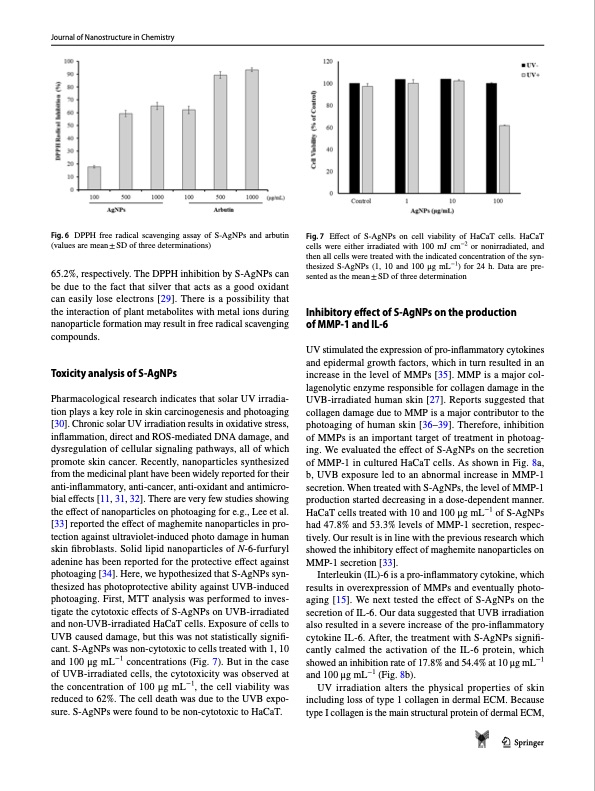
PDF Publication Title:
Text from PDF Page: 007
Journal of Nanostructure in Chemistry Fig. 6 DPPH free radical scavenging assay of S-AgNPs and arbutin (values are mean ± SD of three determinations) 65.2%, respectively. The DPPH inhibition by S-AgNPs can be due to the fact that silver that acts as a good oxidant can easily lose electrons [29]. There is a possibility that the interaction of plant metabolites with metal ions during nanoparticle formation may result in free radical scavenging compounds. Toxicity analysis of S‐AgNPs Pharmacological research indicates that solar UV irradia- tion plays a key role in skin carcinogenesis and photoaging [30]. Chronic solar UV irradiation results in oxidative stress, inflammation, direct and ROS-mediated DNA damage, and dysregulation of cellular signaling pathways, all of which promote skin cancer. Recently, nanoparticles synthesized from the medicinal plant have been widely reported for their anti-inflammatory, anti-cancer, anti-oxidant and antimicro- bial effects [11, 31, 32]. There are very few studies showing the effect of nanoparticles on photoaging for e.g., Lee et al. [33] reported the effect of maghemite nanoparticles in pro- tection against ultraviolet-induced photo damage in human skin fibroblasts. Solid lipid nanoparticles of N-6-furfuryl adenine has been reported for the protective effect against photoaging [34]. Here, we hypothesized that S-AgNPs syn- thesized has photoprotective ability against UVB-induced photoaging. First, MTT analysis was performed to inves- tigate the cytotoxic effects of S-AgNPs on UVB-irradiated and non-UVB-irradiated HaCaT cells. Exposure of cells to UVB caused damage, but this was not statistically signifi- cant. S-AgNPs was non-cytotoxic to cells treated with 1, 10 and 100 μg mL−1 concentrations (Fig. 7). But in the case of UVB-irradiated cells, the cytotoxicity was observed at the concentration of 100 μg mL−1, the cell viability was reduced to 62%. The cell death was due to the UVB expo- sure. S-AgNPs were found to be non-cytotoxic to HaCaT. Fig.7 Effect of S-AgNPs on cell viability of HaCaT cells. HaCaT cells were either irradiated with 100 mJ cm−2 or nonirradiated, and then all cells were treated with the indicated concentration of the syn- thesized S-AgNPs (1, 10 and 100 μg mL−1) for 24 h. Data are pre- sented as the mean ± SD of three determination Inhibitory effect of S‐AgNPs on the production of MMP‐1 and IL‐6 UV stimulated the expression of pro-inflammatory cytokines and epidermal growth factors, which in turn resulted in an increase in the level of MMPs [35]. MMP is a major col- lagenolytic enzyme responsible for collagen damage in the UVB-irradiated human skin [27]. Reports suggested that collagen damage due to MMP is a major contributor to the photoaging of human skin [36–39]. Therefore, inhibition of MMPs is an important target of treatment in photoag- ing. We evaluated the effect of S-AgNPs on the secretion of MMP-1 in cultured HaCaT cells. As shown in Fig. 8a, b, UVB exposure led to an abnormal increase in MMP-1 secretion. When treated with S-AgNPs, the level of MMP-1 production started decreasing in a dose-dependent manner. HaCaT cells treated with 10 and 100 μg mL−1 of S-AgNPs had 47.8% and 53.3% levels of MMP-1 secretion, respec- tively. Our result is in line with the previous research which showed the inhibitory effect of maghemite nanoparticles on MMP-1 secretion [33]. Interleukin (IL)-6 is a pro-inflammatory cytokine, which results in overexpression of MMPs and eventually photo- aging [15]. We next tested the effect of S-AgNPs on the secretion of IL-6. Our data suggested that UVB irradiation also resulted in a severe increase of the pro-inflammatory cytokine IL-6. After, the treatment with S-AgNPs signifi- cantly calmed the activation of the IL-6 protein, which showed an inhibition rate of 17.8% and 54.4% at 10 μg mL−1 and 100 μg mL−1 (Fig. 8b). UV irradiation alters the physical properties of skin including loss of type 1 collagen in dermal ECM. Because type I collagen is the main structural protein of dermal ECM, 13PDF Image | green silver nanoparticles from leaf used as UVb protection

PDF Search Title:
green silver nanoparticles from leaf used as UVb protectionOriginal File Name Searched:
Role_of_green_silver_nanoparticles_synthesized_fro.pdfDIY PDF Search: Google It | Yahoo | Bing
Turbine and System Plans CAD CAM: Special for this month, any plans are $10,000 for complete Cad/Cam blueprints. License is for one build. Try before you buy a production license. More Info
Waste Heat Power Technology: Organic Rankine Cycle uses waste heat to make electricity, shaft horsepower and cooling. More Info
All Turbine and System Products: Infinity Turbine ORD systems, turbine generator sets, build plans and more to use your waste heat from 30C to 100C. More Info
CO2 Phase Change Demonstrator: CO2 goes supercritical at 30 C. This is a experimental platform which you can use to demonstrate phase change with low heat. Includes integration area for small CO2 turbine, static generator, and more. This can also be used for a GTL Gas to Liquids experimental platform. More Info
Introducing the Infinity Turbine Products Infinity Turbine develops and builds systems for making power from waste heat. It also is working on innovative strategies for storing, making, and deploying energy. More Info
Need Strategy? Use our Consulting and analyst services Infinity Turbine LLC is pleased to announce its consulting and analyst services. We have worked in the renewable energy industry as a researcher, developing sales and markets, along with may inventions and innovations. More Info
Made in USA with Global Energy Millennial Web Engine These pages were made with the Global Energy Web PDF Engine using Filemaker (Claris) software.
Infinity Turbine Developing Spinning Disc Reactor SDR or Spinning Disc Reactors reduce processing time for liquid production of Silver Nanoparticles.
| CONTACT TEL: 608-238-6001 Email: greg@infinityturbine.com | RSS | AMP |